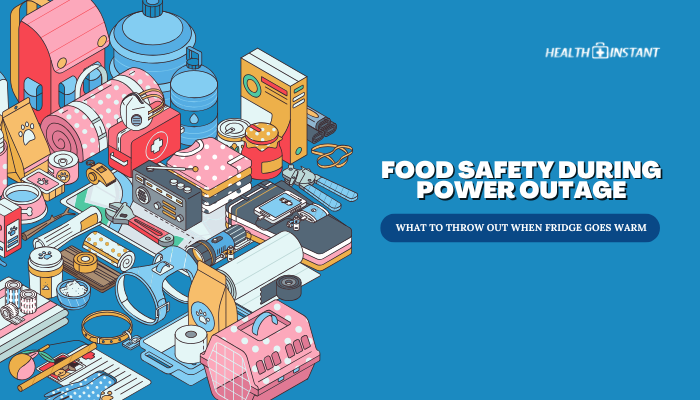Introduction
A power outage can quickly turn your refrigerator into a warmer environment that fosters bacterial growth. As the hours pass without power, perishable foods approach the “danger zone” of 40°F (4°C) or higher, risking spoilage or foodborne illness.
Knowing how long certain foods remain safe and which should be thrown out once temperatures rise is critical to safeguarding your health. This guide outlines key tips for deciding what’s still safe to eat, how to keep items cold longer, and how to handle post-outage restocking.
Why Power Outages Are a Food Safety Risk
- Loss of Refrigeration
- Temperatures that climb above 40°F allow bacteria like Salmonella or Listeria to multiply.
- Uncertain Timeframes
- Without precise knowledge of exactly how long the fridge has been warm, identifying borderline items can be tricky.
- Uneven Cooling
- Some sections of your fridge or freezer may warm faster than others, especially the door or top compartments.
General Rules: Time and Temperature
- 4 Hours at 40°F
- If refrigerator or food stays at 40°F (4°C) or below for up to 4 hours without power, most perishable items remain safe.
- Check Freezer
- A full freezer often maintains safe temperatures for about 48 hours if unopened; a half-full freezer lasts around 24 hours.
- Thermometer Use
- A dedicated appliance thermometer provides real-time checks, guiding decisions.
Which Foods to Discard Immediately
If the fridge was above 40°F for more than 2 hours or you’re unsure about the time/temperature:
- Meat, Poultry, Seafood
- Raw or cooked meats, fish, eggs.
- Dairy Items
- Milk, cream, sour cream, and soft cheeses (e.g., cottage cheese, ricotta).
- Cooked Leftovers
- Stews, soups, casseroles, or other prepared meals.
- Egg-Based Products
- Custards, puddings, mayonnaise, certain salad dressings.
- Cut Fruits and Vegetables
- Pre-washed, sliced produce can harbor bacteria if warm for too long.
Despite no visual or odor changes, these foods can develop harmful bacteria.
Which Foods May Be Safe
Certain items are more tolerant of temperature changes:
- Hard Cheeses
- Cheddar, Swiss, and Parmesan can last longer if sealed.
- Butter and Margarine
- Usually remain safe if they haven’t liquefied in extremely high temps.
- Condiments
- Jelly, jams, peanut butter, olives, pickles, ketchup, mustard, vinegar-based dressings—lower risk due to preservatives or acidity.
- Fresh, Uncut Produce
- Whole fruits and vegetables typically remain safe, though some (like fresh mushrooms or soft berries) degrade faster in heat.
When in doubt, check texture or smell, but these items pose a lower risk than meats/dairy.
Practical Tips to Maintain Cold Temperatures
- Keep Doors Closed
- Every door opening causes temperature spikes, so minimize checking.
- Group Items
- Storing them close helps them remain chilled collectively.
- Coolers and Ice
- If the outage is prolonged, pack a cooler with ice for essential items (milk, medication).
- Pre-Freeze Water Jugs
- They act as ice packs and provide safe drinking water later.
Inspecting and Smelling Before Eating
- Look for Discoloration or Texture Changes
- Meat looking grayish or slimy is a red flag.
- Avoid Relying Solely on Odor
- Some bacteria produce no smell. If uncertain, toss it.
- Use a Food Thermometer
- If you can re-chill items quickly, check internal temperatures. Cooking thoroughly can kill some pathogens, but toxins might remain.
Remember: “When in doubt, throw it out.”
Restocking Safely After Power Returns
- Clean and Sanitize
- If the fridge was off long, wipe all surfaces with a mild bleach solution.
- Check Freezer
- If items still have ice crystals or are at 40°F or below, they may be refrozen.
- Update Inventory
- Properly label new stock to track usage and avoid future confusion.
Conclusion
Power outages can compromise food safety within hours, especially for perishable items. Understanding the 40°F threshold, applying the 4-hour rule, and quickly transferring or discarding certain foods helps prevent foodborne illnesses.
A well-stocked cooler, an appliance thermometer, and a focus on minimal fridge opening can help salvage more items. Above all, if you’re unsure about anything in a warmer fridge, discard it—better to lose food than risk illness.
References
- U.S. Food and Drug Administration (FDA). (2022). Food safety during power outages.
- Centers for Disease Control and Prevention (CDC). (2021). Preventing foodborne illnesses in emergencies.
- USDA Food Safety and Inspection Service. (2020). Refrigerator & freezer storage.
- American Red Cross. (2019). Power outage safety tips.
Disclaimer: This guide offers general advice and is not a substitute for local guidelines. Always use your best judgment and official advisories for specific power outages and health regulations.

